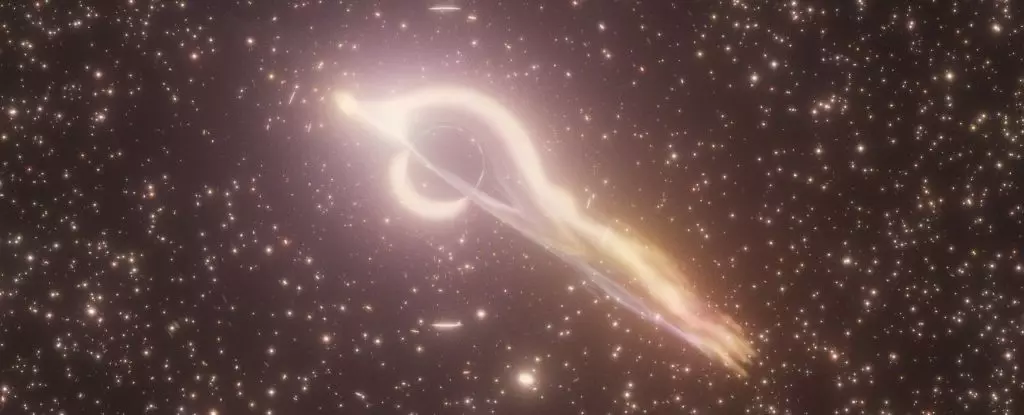For decades, astronomers have grappled with one of the universe’s most profound enigmas: how do black holes, particularly the colossal supermassive kind, come into existence? While stellar-mass black holes and supermassive giants are well-documented, the “middleweight” black holes have remained elusive, almost like cosmic whispers that are difficult to hear. Recent discoveries, however, have begun to shed light on these mysterious objects, giving us crucial insights into the evolutionary pathways of black holes and the growth of galaxies themselves.
The recent detection of an intermediate-mass black hole (IMBH) candidate ignites a fascinating debate about the life cycle of black holes. Captured through dynamic X-ray emissions in a galaxy some 450 million light-years away, this black hole’s behavior blurs the classical boundaries that once separated the known black hole populations. Its fleeting brightness and energetic outputs place it squarely in the narrow, largely uncharted mass window between 1,000 and 10,000 solar masses—an identification that expertise like that of astronomer Yi-Chi Chang suggests is not only plausible but revolutionary.
Why the Intermediate-Mass Black Hole Challenge Matters
The importance of discovering an intermediate-mass black hole cannot be overstated. In the larger cosmic puzzle, it raises critical questions: Are we missing a crucial link in black hole evolution? Does the presence of IMBHs suggest alternative formation mechanisms for the supermassive black holes at the centers of galaxies? Until now, theoretical models favored two primary routes: stellar remnants collapsing into black holes and the mergers or direct collapses of gas clouds forming supermassive objects. Yet, the scarcity of objects in the 100 to 1 million solar mass range has left a void in our understanding.
Observations like HLX-1 disrupt this gap, providing tangible evidence for intermediate-mass black holes that might act as “building blocks” in the cosmic assembly line. If black holes grow by accreting gas or merging with other black holes, then the existence of these objects is vital for confirming that process. Their rare appearance suggests they may be intermediate stages—a stepping stone between the stellar and supermassive classifications—holding clues about how black holes reach their awe-inspiring sizes.
The Implications for Galaxy Formation and Evolution
The presence of intermediate-mass black holes also redefines our understanding of galaxy formation. Central supermassive black holes dominate the cores of most galaxies, including our own Milky Way. How these monsters grow so rapidly, under what conditions, and from what initial seeds, depends heavily on finding the right intermediate stages. The first signs of these stages are crucial; they reveal the processes by which matter coalesces and collapses in the tumultuous early universe.
This discovery isn’t just about cataloging a new class of black holes—it’s about deciphering the cosmos’s blueprint. It hints at a universe that might be more complex than our current models suggest, where black hole growth is a series of incremental steps rather than sudden leaps. If IMBHs are indeed common, they could act as the “missing links,” helping us understand how matter funnels into supermassive behemoths and how galactic nuclei evolve over billions of years.
The Future of Black Hole Research and the Quest for Clarity
The intrigue surrounding HLX-1 and similar candidates underscores the necessity for more sensitive telescopes and dedicated observations. Astronomers are eager to confirm whether this black hole is a one-time feast or if it is involved in a continuous feeding frenzy—perhaps consuming a companion star on a regular basis. The motion, frequency, and intensity of future flares could revolutionize our models of black hole feeding behavior and growth.
Furthermore, this discovery fuels the broader debate about the origins of supermassive black holes. Did they emerge from the primordial universe, forming directly from collapsing gas clouds? Or did they evolve gradually from these intermediate stages as they continue to feed? These are questions only further observation and advanced modeling can answer. But for now, the detection of an intermediate-mass black hole marks a significant milestone—one that invigorates Einstein’s gravitational universe and our quest to understand its most extreme objects.
In the end, the universe continually surprises us. The unveiling of these elusive black holes reshapes our cosmic narrative, hinting that the story of black hole formation is richer and more layered than previously believed. Each discovery pushes the boundaries of human knowledge, forcing us to reconsider the grand architecture of the cosmos and our own place within it.

